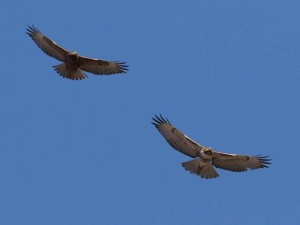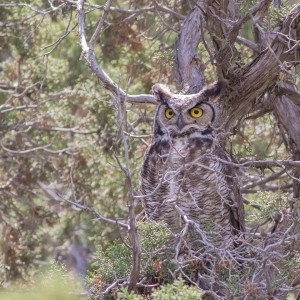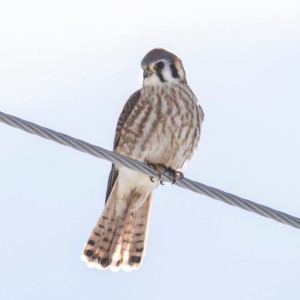
Kestrel. Photo: Shon Reed
Since we moved to Quail Run Farm three years ago, we have seen a variety of wildlife. There is usual the wildlife you would expect to see in the high desert. My favorite sights is the majestic flight of the local birds of prey. We have seen eagles, red-tailed hawks, kestrels, owls, and many other different types of birds of prey. A lot of people have posted pictures of the birds, scenes and other wildlife around Eagle Mountain on the Scenes From Eagle Mountain Facebook page.
It has been fun watching a mating pair of Red-Tail Hawks raise their second season of babies on a high voltage power line in the agricultural lot next to us. They have a nest in one of the cross beams, and can be seen perching on the power poles.
We have seen other types of birds of prey including several different types of owls. You never have experienced the full power of these birds, unless you are face to face with one trying to get it to exit your chicken coop. You can read all about that experience here: http://www.momzoolife.com/2014/02/07/the-web-of-protection/.
One of my favorite Birds of Prey is the American Kestrel. Eagle Mountain is home to many kestrels. Driving though the city you may notice several poles, with boxes on them placed in locations in and around Eagle Mountain.
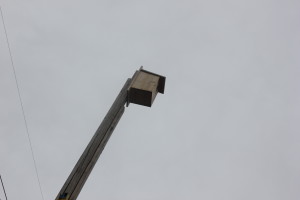
Kestrel nesting box. Photo: Aimee Kieffer
These poles and nesting boxes have been the product of the Eagle Mountain Kestrel Project, which Quail Run Farm has had the pleasure of being part of. If you are interested, you can find the location of these boxes by visiting the Kestrel Pole Location map. The mayor of Eagle Mountain, Christopher Pengra talked about this project in his February 2016 State of the City blog post.
Preserving our natural beauty extends to our birds of prey, too. This year a resident by the name of Shon Reed worked with Austin Robinson, an Eagle Scout, to build nest boxes for American Kestrels. Shon also worked with Brian Smith from Rocky Mountain Power to get utility poles in the ground for mounting the nest boxes to. He also organized volunteers to place these boxes throughout the City. The next step is to get those boxes on a map so residents can observe the birds as they use the poles and boxes. This work is a testament to the selflessness of the people who live here. – Mayor Chris Pengra
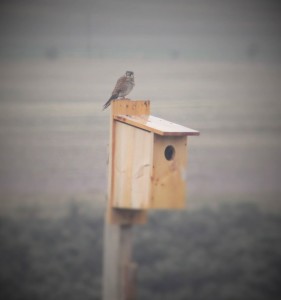
Kestrel sitting on a nesting box on Quail Run Farm. Photo: Aimee Kieffer
The Forest Preserve District of Kane County also has a kestrel box program that they are working on.
The Forest Preserver District of Kane County has about 30 kestrel nest boxes in the field. Occupancy was just 8 percent in 2015 but the district remains optimistic. it checked with Audubon chapters around the Midwest with similar programs and learned that kestrel box programs often have low success in the first few years, followed by dramatic improvement once a few boxes become occupied. – Jeff Reiter (Dailyherold.com)
Giving the kestrels places to nest is just part of the equation. There are a lot of factors in increasing the kestrel population in an area. Nesting boxes are the first step, but not only do we need to give them a home, we need to protect and increase their hunting areas.
Eric Cirino, for the Audubon, recently wrote an article entitled, “Are Kestrels the New Poster Species for Pesticides?” The article points out that even after the ban on DDT (dichlorodiphenyltrichloroethane) the larger birds of prey have seen an increase in population. But the population of the American Kestrel is still on a steady decline. “According to the North American Breeding Bird Survey, there are about 4 million American Kestrels living in the Lower 48, Mexico, and nearly all of Canada and Alaska. That’s 66 percent fewer kestrels than there were in 1966.” Eric continues to draw the conclusion that the reason why the kestrel populations are still declining is because of the urbanization of its hunting grounds, and the use of other pesticides that kill the kestrels main source of food.
Wohler confirms that kestrel populations in Long Island have dropped significantly over the past several decades, too. Rampant development and pesticide use on farms and suburban lawns in the area could be the root of the cause. [Source]
Kestrels have a wide variety of food sources, but the majority of their food is insects.
American Kestrels eat mostly insects and other invertebrates, as well as small rodents and birds. Common foods include grasshoppers, cicadas, beetles, and dragonflies; scorpions and spiders; butterflies and moths; voles, mice, shrews, bats, and small songbirds. American Kestrels also sometimes eat small snakes, lizards, and frogs. And some people have reported seeing American Kestrels take larger prey, including red squirrels and Northern Flickers.
…
Current declines stem from continued clearing of land and felling of the standing dead trees these birds depend on for their nest sites. The American Kestrel is also losing prey sources and nesting cavities to so-called “clean” farming practices, which remove hedgerows, trees, and brush. An additional threat is exposure to pesticides and other pollutants, which can reduce clutch sizes and hatching success. For kestrels in North America, a larger problem with pesticides is that they destroy the insects, spiders, and other prey on which the birds depend.- allaboutbirds.org
Quail Run Farm is doing what it can to help protect the habitat and hunting grounds of the Kestrel, and we would like to ask you to help us with this goal. There are two major ways that residents of Eagle Mountain can help increase the kestrel population.
First, keep open land that is ideal for kestrel hunting areas. We can let the City Council and other elected officials know that we support keeping areas as agricultural and open for kestrel habitat. We recently had a developer propose a 60+ home development on what is currently agricultural land in close proximity to Quail Run Farm. A group of residents got together and were able to stop this land from being rezoned from agricultural to residential. In doing so, we have increased the chances that the kestrel population in Eagle Mountain will grow. I am not talking about improved green space, that most developments are required to put in. I am talking about preserving the native, natural green space that attracts the kestrel to the area. One of the things that makes Eagle Mountain unique is the natural habitat we have. There is no need to manicure, develop, and plow down all of the areas in Eagle Mountain. Eagle Mountain currently has an area of 41.7 Square Miles, there is plenty of space for development, as well as keeping native open space intact.
Eagle Mountain has a large power and gas corridor that runs from the north end to the south end of the city. We as residents need to try to keep that corridor free of residential zoning. Keep it zoned so that it stays native and is the ideal location for kestrels and other birds of prey to hunt. Lets preserve as much of their natural, native hunting grounds as possible. By placing nesting boxes along the power corridor, we can encourage the kestrel population in Eagle Mountain.
Second, don’t kill insects unless you have to. Not all insects are bad or evil. As long as insect populations are kept in check, they can actually be beneficial. And the majority of the time, the balance is kept if left to its own devices. If the insect is not causing a health risk, then we should maybe think about not using insecticides to eliminate it. Insecticides are non discriminating killers. By using insecticides to get rid of spiders, you are also eliminating other beneficial bugs as well. Kestrels require insects to survive, and as development continues, residents will spray their manicured lawns, and properties to eliminate the possibility that there may be a harmful insect.
The next time you spray an insecticide to kill a bug, think about the other bugs that may also be eliminated from the overspray, or what animals may be effected by the loss of that insect. If it is not a health risk, think about leaving it as is.
An article by Caroline Cox titled “Pesticides and Birds: From DDT to Today’s Poisons” in the Journal of Pesticide Reform discusses the dangers of pesticides and birds. Besides a long list of pesticides that kill birds, Cox discusses the secondary poisoning of predatory birds, the indirect effects of starvation and predation, and the more sub lethal effects. She concludes by saying:
Pesticides will continue to kill birds, reduce their food resources, and disrupt their normal behaviors as long as pesticides continue to be used. The only way to eliminate the effects that pesticides have on birds is to use nonchemical resource management techniques. On farms, in forests, on lawns, and elsewhere that pesticides are used, managers are finding that these techniques work well and make economic sense. Our job is to see that they are implemented more widely.
This is not a simple task, but one that is essential if we are to seriously heed the message of our miners’ canaries.
Everyone can do their part to help increase the kestrel population in Eagle Mountain. We can help the Kestrel Project by monitoring, installing, and facilitating the use of nesting boxes. We can help by encouraging the City Council and developers to leave natural and native open spaces. We can help by thinking twice about using pesticides, insecticides and herbicides on the properties we own or maintain.
Kestrel Facts
- The kestrel does not build a nest but instead relies on taking over crevices, hollows in trees, and the nests of other birds. This makes it easy to attract them to nest boxes.(a)
- The lack of suitable nesting sites is often the greatest limiting factor for kestrel populations.(a)
- Kestrels prefer nest boxes over natural cavities, mainly because most natural cavities are more cramped than manmade boxes.(a)
- The kestrel is an inhabitant of open fields, croplands, and orchards.(a)
- Once widely known as “the sparrow hawk”, the name kestrel is now more commonly used.(a)
- Although kestrels generally migrate southward in the winter, they return to their previous territories and nest sites year after year.(a)
- Females tend to winter farther south than males.(a)
- A kestrel family will eat upwards of 500 voles or mice per year as well as numerous grasshoppers and locusts.(a)
- Kestrels generally begin breeding in early April or May, but often breeding activity reaches its peak in early June.(a)
- The common name, American Kestrel, is used to distinguish the species that lives in North America (Falco sparverius) from its old world cousin, the European Kestrel (Falco tinnunculus).(a)
- Unlike humans, birds can see ultraviolet light. This enables kestrels to make out the trails of urine that voles, a common prey mammal, leave as they run along the ground. Like neon diner signs, these bright paths may highlight the way to a meal—as has been observed in the Eurasian Kestrel, a close relative.(b)
- Kestrels hide surplus kills in grass clumps, tree roots, bushes, fence posts, tree limbs, and cavities, to save the food for lean times or to hide it from thieves.(b)
- The oldest American Kestrel was at least 14 years, 8 months old.(b)
- Kestrels were once hunted by gamekeepers. However, they are now one of the few birds of prey that gamekeepers and farmers tolerate as they eat the rats, moles, and insects that farmers see as pests.(c)
Fact Source Websites: (a) barnowlbox.com, (b) allaboutbirds.com, (c) nottinghamshirewildlife.org
Photos: Shon Reed allowed us to use some of his photos on this post. You can follow him on instagram. He has taken a lot of cool pictures of Birds of Prey around the farm and the Eagle Mountain Area.
The following is a small gallery or showing of the birds of prey that have been taken by Shon Reed and posted to various Eagle Mountain facebook pages.
Books about Kestrels
[amazonjs asin=”0878426361″ locale=”US” title=”American Kestrel: Pint-sized Predator”]
[amazonjs asin=”1555663532″ locale=”US” title=”The American Kestrel: Falcon of Many Names”]

